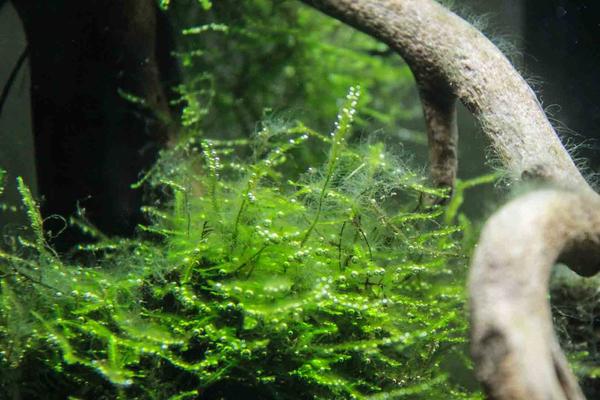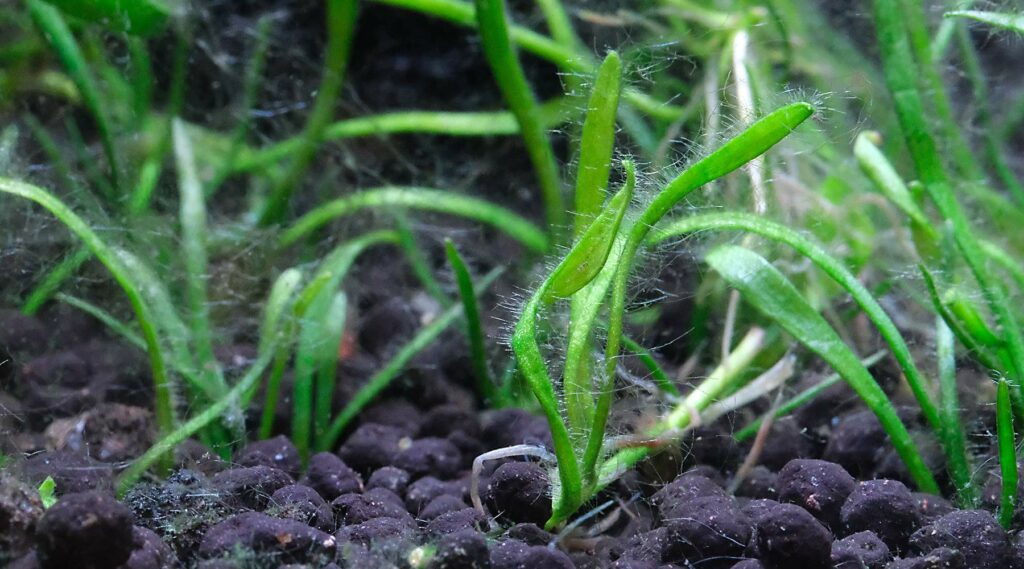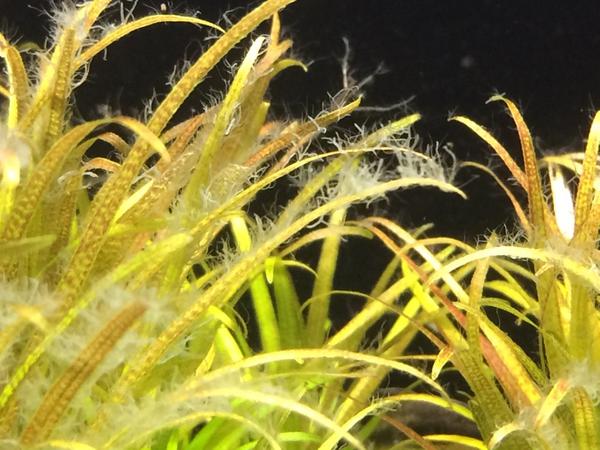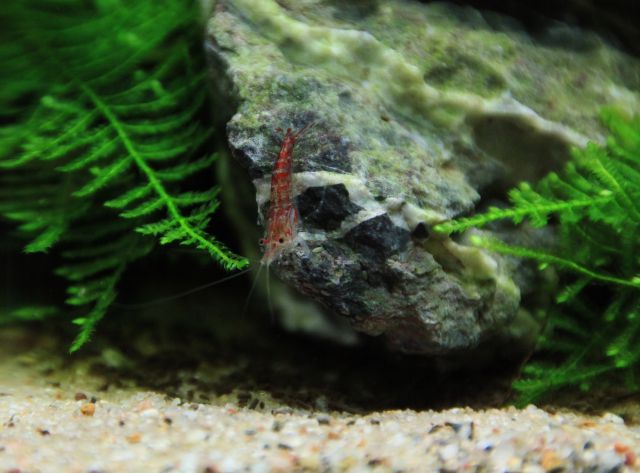Fuzz algae is a term that describes short, green, and filamentous aquarium algae.
These algae can grow on plants, decorations, or even on your tanks’ glass. If there are a lot of them, they can even form a thick coat. As the name suggests, they’re fuzzy-looking.
They’re sometimes confused with hair algae, but they’re not the same, although some people think it’s an early stage of hair algae.
There can be several causes for fuzz algae in an aquarium, so the more you know about them, the more chances that you will be able to prevent these invasions. It’s also easier to control fuzz algae.
Luckily, there are solutions to get rid of fuzz algae if they get out of control. And the good news is that you can find all that information in our article.

Contents
General Causes Of Fuzz Algae
If you see fuzz algae in your aquarium, it means there’s probably an imbalance of some kind in your tank’s ecological system. In this section, you can find the general causes of fuzz algae.
These invasions can happen in both young and old fish tanks. Fuzz algae are usually fine and not dangerous.
In fact, unlike other algae types, you can leave some in your tank as long as you keep them under control. Remember, some fuzz algae are fine, but you don’t want it to take over your entire fish tank.
- Young tanks
It can happen in young tanks because they haven’t reached their full maturity cycle yet, which can result in some imbalances for the first few weeks. This can take four to eight weeks, and we don’t recommend that you add any tank population before the cycle is complete.
- Older tanks
As far as mature tanks are considered, fuzz algae can appear if there’s a sudden imbalance in macro-nutrients.
- Low-oxygen levels
It could also be that the oxygen levels in your tank are far too low,you can adjust that by adding some aquatic plants to your aquarium. In this case, you can keep some fuzz algae in your tank.
If there are too many fuzzy algae in your fish tank, they can deprive other plants of oxygen, so make sure you control the algae population.
Control Fuzz Algae
- Fuzz algae eaters
You can control the fuzz algae population in your aquarium naturally by adding fuzz algae eaters to your tank.
Shrimps and/or fish that like to eat these algae are not only great to keep your tank clean, control the algae population but are also very fun to watch.
You could even get a couple of them and set up your own clean-up crew! You have nothing left to do except take care of them.
Before you add any new fish or shrimps to your aquarium, make sure they’re compatible with your existing tank population.
Ideally, you should also quarantine them, so they don’t bring any illnesses to your set-up tank. Also, check what their care needs are and if they’re adapted for your current tank conditions.
We did the research for you and have some suggestions of good fuzz algae eaters you can add to your tank to control the algae population.
If you like shrimps, you can add Amano shrimps. Other shrimp species won’t be good to eat this algae type specifically.
There are some fish options as well, such as Siamese algae eaters (SAE) fish, Otocinclus fish, Bristlenose Pleco fish, and Black Molly fish.
Be careful before you add shrimp and fish together in your tank, as some fish species can eat the shrimp. Also, as they’re so small, they can get caught in your tank’s filters.
If you pick your fuzz algae eaters well, you’ll have your fuzz algae population under control in no time.
- Keep your tank clean
To keep fuzz algae under control, you should keep your tank clean by removing any food residue, organic waste, fish waste and by changing the aquarium’s water regularly.
In general, it’s not good to overfeed your fish, as it makes the tank dirty, and it’s also not healthy for them.
So keep on top of your cleaning! It’s so essential for your tank and to keep fuzz algae under control.
You can then remove any fuzz algae residue manually with a wipe. There’s no need to add chemicals.
If your algae invasion is critical, you should talk to a specialist so that they can advise you best for your type of situation.

Solutions To Get Rid Of Fuzz Algae
- Setting up a big cleanup crew
You can get rid of fuzz algae completely by introducing fuzz algae eaters. If you do your research, you can set up your own cleaning crew. The more of them you get, the cleaner your tank will be.
You shouldn’t overfeed these shrimps or fish as otherwise, they won’t eat algae as much, but also depends on the different species, so please check for each of them beforehand.
- Nutrient levels and oxygen check
If you want another efficient way to get rid of fuzz algae and you don’t necessarily want to add more fish or shrimp to your tank, you should check your aquarium’s nutrient levels.
You can simply run a quick test to check these levels. If they’re too high or too low, you can adjust accordingly. Usually, fuzz algae thrives when there are high nutrient levels in an aquarium. So you want to avoid this.
Another thing you should check in your aquarium is the oxygen level. If it’s too low, your other aquatic plants can’t outcompete fuzz algae. So make sure to adjust the CO2 level.
Once it’s high enough, you can add more plants to your aquarium to prevent any more fuzz algae from appearing.
For example you can get a stronger filter and a better air pump. If you have a good filtration system and your tank’s equipment is up-to-date, you should have no problem in getting rid of fuzz algae.
- Perform regular water changes
Ideally, you should perform water changes weekly just to keep your tank clean and to make sure that your aquarium conditions stay the same to preserve your tank population.
Of course, you should also perform regular water changes to avoid any bacteria, fungus, fuzz algae, and any other type of invasive algae.
Each tank needs different water changes and different percentages, so check which requirements you should follow. Also, be careful about your tank population while you perform water changes.
FAQ
Here’s a quick FAQ about fuzz algae, where you can find everything we didn’t mention above. If you have a question about these algae specifically, you can find your answers here.
How do you get rid of algae fuzz?
We already touched on that above, but we can sum it up quickly.
To get rid of algae fuzz, the first thing you can do is to add fuzz algae eating animals in your tank.
Certain species of fish and Amano shrimp are great to get rid of fuzz algae invasions. Siamese algae eaters are particularly great.
You can also perform regular changes and then remove any algae fuzz residue manually. As you can see, these are not hard to remove. And, it’s very easy to prevent them from happening in the first place.

What causes fuzz algae?
You can prevent fuzz algae if you know what causes them. This way, you can also keep the algae population under control as well as get rid of it, if that’s what you want.
There’s no need to, but it can get annoying, so we understand if you don’t want any algae invasion in your tank!
If the nutrients are too high or if the oxygen levels are too low in your aquarium, there’s no wonder there are fuzz algae growing in your tank. That actually prevents your other aquatic plants from growing and being happy.
So you can perform regular tests and water changes to improve these, as well as invest in a good filter and air-pump system.
Are fuzz algae harmful to fish?
No. Luckily Fuzz algae are usually not harmful to fish. They’re also not harmful to other creatures or for your tank, as long as you keep them under control.
If they grow too much, they can get your tank dirty, and lower the CO2 level, which can actually be dangerous for your aquatic plants and your fish.
So make sure you either keep the fuzz algae population low or that you remove it completely.
Final Thoughts
It’s pretty easy to control your fuzz algae population in your aquarium, and you can even get rid of it completely if you’d prefer.
There are easy things you can do to control fuzz algae. First, you can maintain your tank and keep it as clean as possible. You can perform regular water changes and nutrient tests.
Finally, you can insert fuzz algae eaters in your aquarium or remove these algae by hand o

Ian Sterling, founder of Fishlab.com, began his aquarium journey over 30 years ago, driven by a deep fascination for fish and their diverse personalities. His website, Fishlab.com, is dedicated to making fishkeeping accessible and enjoyable, offering beginner-friendly guidance, expert insights, and a community for aquarists to connect and share experiences.


